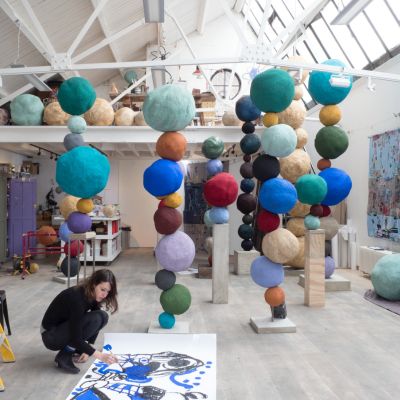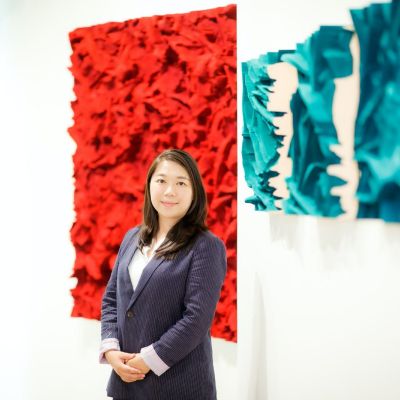Breaking the Mold

Toshiyuki Inoko, founder of teamLab, on refusing to give up on being an artist.

It has always been Toshiyuki Inoko's aim to “explore what the world is for humans”.
This, of course, is through the glorious technicolour digital playgrounds of teamLab: a collective of artists and engineers founded by Inoko some 20 years ago. If you haven’t been living in a cave for the last two decades, you will have seen their work: immersive colourful oceans where you draw a fish on a piece of paper and, minutes later, see it swimming through the coral reefs around you; rooms infinitely lit with a million floating lanterns without walls, ceilings; or, seemingly, a floor, a playful forest full of coloured branches to climb through, and so much more.
This is art unlike any other; and people are making a special journey to see it. Expect queues of an hour or longer outside the collective’s temporary shows which have taken place in New York, London, Paris, Singapore, Silicon Valley, Beijing, Taipei and Melbourne; and, as of later this year, a permanent installation at Macau's Venetian Hotel.
Since 2018, teamLab has had two permanent museums, one in Tokyo and one in Shanghai. In the one year since their openings, teamLab Borderless and teamLab Planets (both museums in Tokyo, one permanent and one temporary) had a combined 3.5 million visitors, that’s a third more than visited New York’s MoMA. These visitors came from over 160 countries and regions around the world. According to a survey conducted by the teamLab Borderless, it appears that about half of the guests visited Tokyo specifically in order to see the museum.
At the beginning though, it was a very different story. teamLab was founded in 2001 by Inoko and five of his recently graduated friends to create a “laboratory to experiment in collaborative creation”. To start with, they funded it through their day jobs; they sold technology solutions and offered digital services to clients during the day and created art late into the night.
“This foundation made it so that we had relatively little pressure to sell art to collectors or worry about finances,” said teamLab. They had no money because their art was “ignored by the Japanese art community” for many years. It was only when they were thrown a lifeline by iconic Japanese artist Takashi Murakami, who included their art in his gallery, that their work started to become respected.
Here, Inoko looks back on the journey.
What is your mission, and have you achieved it?

Our intention is to change people’s standard of beauty, even if it requires a great deal of time.
At some point in history, humans saw flowers and thought ‘beautiful’. But we do not really understand this phenomenon of ‘beauty’. Evolution explains some instances: it is natural that we would perceive other humans to be ‘beautiful’ from a reproductive standpoint.
But this does not explain why humans have found flowers ‘beautiful’. In the time before civilisation, people did not see beauty in something as insignificant as flowers. In other words, we humans attributed the same idea of ‘beautiful’ to targets for reproduction, as well as to unrelated things such as flowers. In theory, we should have used different words for these two completely unrelated concepts, so the fact that we conceive of them in the same way is quite miraculous.
We believe that art is an act of modern people creating their own flowers and expanding the notion of ‘beautiful’ with those flowers, just in the way that ancient human beings saw flowers as ‘beautiful’ and expanded the idea of beauty. We do not instantly understand the reasons or meaning behind this expansion. However, through these positive expansions of ‘beautiful,’ 30 or 50 years later, people may behave differently in a way that we cannot understand with today’s limited knowledge, allowing humanity to continue to grow and thrive.
Creating artwork is always difficult. Our artworks are created by a team of hands-on experts through a continuous process of creation and thinking. Although the large concepts are always defined from the start, the project goal tends to remain unclear, so we need the whole team to create and think as we go along.
Why has teamLab been so successful?
In the beginning, teamLab had neither the opportunity to present ourselves, nor could we imagine how to economically sustain our art creation. On the other hand, we believed in the power of digital technology and creativity, and thus kept creating something new, no matter what genre it would turn out to be. While we took part in various projects to sustain ourselves, we increased the number of technologists such as architects, CG animators, painters, mathematicians and hardware engineers.
As time went on, while teamLab gained passionate followers among young people, we were still ignored by the art world. Our debut finally came in 2011 at the Kaikai Kiki Gallery in Taipei, as we were invited by the artist Takashi Murakami. Since then, teamLab has gained opportunities to join major contemporary art exhibitions in cosmopolitan cities such as Singapore Biennale 2013. In 2014, New York’s PACE Gallery started to help promote teamLab artworks. These factors allowed teamLab to expand rapidly. Finally, in 2015, we were able to organise our own exhibition for the first time in Tokyo. These situations further accelerated our evolution and gave us opportunities to exhibit internationally: New York, London, Paris, Singapore, Silicon Valley, Beijing, Taipei, and Melbourne, among others.
We think this is because teamLab experiences cannot be fully appreciated just on screen but must be felt in person.
Through smartphones or TVs, people can understand only with their heads. Knowledge may be gained, but the sense of values and perceptions cannot be changed or broadened. Only through the actual, physical experience of the world or artworks, people can start to recognise things differently. Even if people look at teamLab exhibitions on Instagram, their values will not be broadened. teamLab wants to continue creating experiences that cannot be shared with photos or videos.
What gave you the inspiration to set up teamLab?

I like science and art. I wanted to know the world, wanted to know humans, and wanted to know what the world is for humans. In college, I wanted to know more about the world, and I majored in physics and mathematics.
Science raises the resolution of the world. When humans want to know the world, they recognise it by separating things. In order to understand the phenomena of this world, people separate things one after another.
For example, the universe and the Earth are continuous, however, humans recognise the Earth by separating it from the universe. To understand the forest, humans break it down into trees, separating the tree from the whole. Humans then cut the tree into cells to recognise the tree, cut the cells into molecules to recognise the cells, and cut the molecules into atoms to understand the molecules, and so on. That is science, and that is how science increases the resolution of the world.
But, in the end, no matter how much humans divide things into pieces, they cannot understand the entirety. Even though what people really want to know is the world, the more they separate, the farther they become from the overall perception.
Humans, if left alone, recognise what is essentially continuous as separate and independent. Everything exists in a long, fragile yet miraculous continuity over an extremely long period of time, but human beings cannot recognise it without separating it into parts. People try to grasp the entirety by making each thing separate and independent.
Even though I am nothing but part of the world, I feel as if there is a boundary between the world and myself, as if I am living independently. I’ve always been interested in finding out why I felt that way even before I started teamLab.
The continuity of life and death has been repeated for more than four billion years. However, for humans, even 100 years ago is a fictional world. I was interested in why humans have this perception.
How can we go beyond the boundaries of recognition? Through art, I wanted to transcend the boundaries of our own, and of my own recognition. I wanted to transcend human characteristics or tendencies to recognise the continuity.
How do you relax? Do you ever digitally detox?
I go to see scenery created by the interactions between nature and humans that transcends my existence.
For example, the Honghe Hani Rice Terraces were a place formed by the accumulation of interaction and activities between people and nature over the course of a time indefinitely longer than my own existence.
The shapes of the terraces themselves embody the continuity and borderlessness of the relationship between humans and nature. Perhaps if we spend hundreds of years in these places, we can comprehend this continuity of time and life. But that is impossible for most people.
So we create exhibitions such as ‘teamLab SuperNature’ or ‘teamLab: A Forest Where Gods Live’ in the nature of Mifuneyama Rakuen, where we can try to condense hundreds of years of existence, so by being in the museum for an hour, one can begin to grasp the continuity of life.
This article originally appeared in Billionaire's Legacy Issue, March 2020. To subscribe contact








